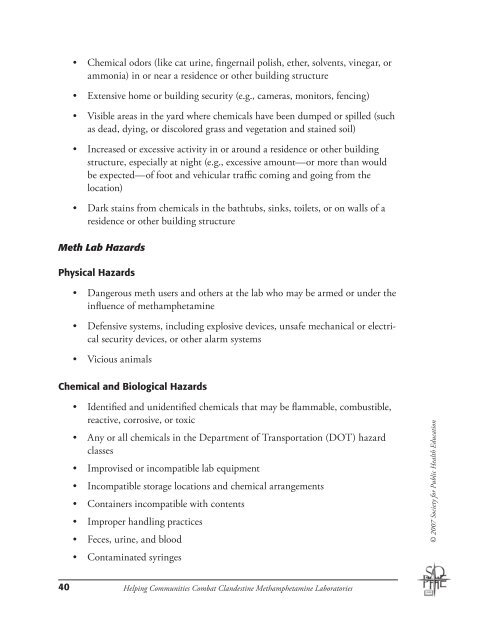Part A - Society for Public Health Education
Part A - Society for Public Health Education
Part A - Society for Public Health Education
- No tags were found...
Create successful ePaper yourself
Turn your PDF publications into a flip-book with our unique Google optimized e-Paper software.
• Chemical odors (like cat urine, fingernail polish, ether, solvents, vinegar, orammonia) in or near a residence or other building structure• Extensive home or building security (e.g., cameras, monitors, fencing)• Visible areas in the yard where chemicals have been dumped or spilled (suchas dead, dying, or discolored grass and vegetation and stained soil)• Increased or excessive activity in or around a residence or other buildingstructure, especially at night (e.g., excessive amount—or more than wouldbe expected—of foot and vehicular traffic coming and going from thelocation)• Dark stains from chemicals in the bathtubs, sinks, toilets, or on walls of aresidence or other building structureMeth Lab HazardsPhysical Hazards• Dangerous meth users and others at the lab who may be armed or under theinfluence of methamphetamine• Defensive systems, including explosive devices, unsafe mechanical or electricalsecurity devices, or other alarm systems• Vicious animalsChemical and Biological Hazards• Identified and unidentified chemicals that may be flammable, combustible,reactive, corrosive, or toxic• Any or all chemicals in the Department of Transportation (DOT) hazardclasses• Improvised or incompatible lab equipment• Incompatible storage locations and chemical arrangements• Containers incompatible with contents• Improper handling practices• Feces, urine, and blood• Contaminated syringes© 2007 <strong>Society</strong> <strong>for</strong> <strong>Public</strong> <strong>Health</strong> <strong>Education</strong>40 Helping Communities Combat Clandestine Methamphetamine Laboratories
















